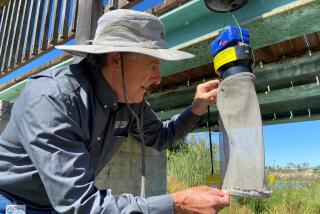Health Official Says Spread of AIDS Is Slowing in County
- Share via
The spread of AIDS in Orange County is slowing, and there is little likelihood that the much-feared spread of the incurable disease into the general population will occur here, an Orange County health official said Thursday.
Speaking at a major AIDS conference for doctors, nurses and other health professionals in the city of Orange, Orange County epidemiologist Dr. Thomas J. Prendergast said, “There is not a high risk that AIDS will spread to the general, heterosexual population.
“It is now clear from the data that we have gathered that heterosexual intercourse is not a major route of transmission of the disease,” Prendergast told 250 people attending the daylong session. It was sponsored by the Orange County Health Care Agency at the Doubletree Hotel.
“Less than 3% of the people who have AIDS in Orange County got it through heterosexual contacts,” he added.
Prendergast said most of these people had contracted the disease through sexual relations with individuals from high-risk groups, particularly intravenous drug users.
Although the rate at which AIDS is spreading is decreasing locally, Prendergast nonetheless cautioned that the actual number of people who will come down with the disease will more than double from the current 620 to an estimated 1,500 by 1990.
“We will be seeing the playing-out of the disease in those who are already infected,” said Prendergast, whose office has been tracking AIDS in Orange County since 1980.
“It can take up to 7 1/2 years for people infected with the AIDS virus to come down with the disease,” he said. “So, over the next two years, we will be seeing people get AIDS because they became infected with the virus in the late ‘70s and early ‘80s--before we started educating people about the disease in 1983.”
Other speakers agreed with Prendergast’s optimistic assessment. But Dr. Charles A. Robertson, who treats many AIDS patients at his Costa Mesa office, warned that heterosexuals should continue to use care with their sexual partners.
“There are more people than you think who lead secret lives as homosexuals, bisexuals or intravenous drug users,” Robertson said. “They don’t tell their sexual partners, or spouses, until after they test positive for the virus.”
Prendergast said, however, that the likeliest route of transmission to the larger population would be through intravenous drug users and prostitutes, many of whom are also drug addicts.
But only 3% of Orange County women inmates arrested for prostitution have tested positive for exposure to the AIDS virus, Prendergast said.
“Prostitutes in Orange County, especially those who go door-to-door serving (Latino) illegal immigrants in central Orange County, have been responsible for repeated epidemics of various kinds in Orange County. But this is not happening with AIDS,” he said.
Prendergast added that intravenous drug users in Orange County were not turning out to be a major conduit of the disease to the larger community. Only 3% of those with AIDS in Orange County are intravenous drug users, unlike New York City, where Prendergast said 80% of those now contracting the disease got it while using nonsterilized needles to inject drugs.
“On the East Coast, drug addicts have a difficult time getting syringes, so they have to go to shooting galleries where they rent needles that are used up to 500 times a day,” Prendergast said.
Because of concern that a lot of drug users continue to share dirty needles and spread the disease to the larger community through sexual relations with unsuspecting partners, Penny Weismuller, Orange County’s AIDS coordinator, said the county would be increasing its educational program among addicts by hiring additional staff.
More to Read
Sign up for Essential California
The most important California stories and recommendations in your inbox every morning.
You may occasionally receive promotional content from the Los Angeles Times.










